|
|
|
Sort Order |
|
|
|
Items / Page
|
|
|
|
|
|
|
| Srl | Item |
| 1 |
ID:
132687
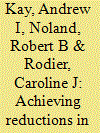

|
|
|
|
|
| Publication |
2014.
|
| Summary/Abstract |
It is well established that GHG emissions must be reduced 50 to 80% by 2050 in order to limit global temperature increase to 2 °C. Achieving reductions of this magnitude in the transportation sector is a challenge and requires a multitude of policies and technology options. The research presented here analyzes three scenarios: changes in the perceived price of travel, land use intensification, and increases in transit. Elasticity estimates are derived using an activity-based travel model for the state of California and broadly representative of the US. The VISION model is used to forecast changes in technology and fuel options that are currently forecast to occur in the US for the period 2000-2040, providing a life-cycle GHG forecast for the road transportation sector. Results suggest that aggressive policy action is required, especially pricing policies, but also more on the technology side, especially increases in the carbon efficiency of medium and heavy-duty vehicles.
|
|
|
|
|
|
|
|
|
|
|
|
|
|
|
|
| 2 |
ID:
169713
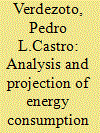

|
|
|
|
|
| Summary/Abstract |
A forecast model for the Ecuador energy sector was elaborated, by using LEAP model, this study aims to analyze the behavior of the energy matrix depending on energy forecast and efficiency policy scenarios, applying a bottom-up analysis and considering the latest politics/infrastructure planning background in Ecuador. The model and considerations proposed will result in a final energy consumption of 158 million BOE in 2030, in which the transportation sector is the main energy consumer. Regarding Ecuador energy planning, of which a critical point is the hydroelectricity available due to the commissioning of new hydro power plants, estimated at 63,513 Gwh in 2030, this value is 3.25 times that generated in 2010. In addition, the energy saving of 15 million BOE is forecast, as well as the reduction in GHG emission related to that saving due to the energy efficiency program PEC, which replaces LPG stoves with induction stoves in Ecuadorian households. Results point out that energy efficiency policies for the transportation sector would reduce oil products (2.97% in the high growth scenario), which could be reallocated to the industrial sector. Finally, another critical point is the rapid decline in the oil self-sufficiency, estimated at 15 years counted from 2030.
|
|
|
|
|
|
|
|
|
|
|
|
|
|
|
|
| 3 |
ID:
091526
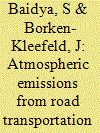

|
|
|
|
|
| Publication |
2009.
|
| Summary/Abstract |
India has become one of the biggest emitters of atmospheric pollutants from the road transportation sector globally. Here we present an up-to-date inventory of the exhaust emissions of ten species. This inventory has been calculated bottom-up from the vehicle mileage, differentiating by seven vehicle categories, four age/technology layers and three fuel types each, for the seven biggest cities as well as for the whole nation. The age composition of the rolling fleet has been carefully modelled, deducting about one quarter of vehicles still registered but actually out-of-service. The vehicle mileage is calibrated to the national fuel consumption which is essential to limit uncertainties. Sensitivity analyses reveal the primary impact of the emission factors and the secondary influence of vehicle mileage and stock composition on total emissions. Emission estimates since 1980 are reviewed and qualified. A more comprehensive inspection and maintenance is essential to limit pollutant emissions; this must properly include commercial vehicles. They are also the most important vehicle category to address when fuel consumption and CO2 emissions shall be contained.
|
|
|
|
|
|
|
|
|
|
|
|
|
|
|
|
| 4 |
ID:
133106


|
|
|
|
|
| Publication |
2014.
|
| Summary/Abstract |
The last two decades of economic decline in Africa have drawn attention to the crisis of masculinities, to "failed men" unable to build kinship networks and to "violent men" who damage social networks whilst competing for scarce resources. This article argues that a fragmented, neo-liberal society also produces new patterns of patriarchal aggrandisement. Focusing on Johannesburg's minibus-taxi industry, it shows how large informal sector activities are structured through kinship networks that in turn give rise to modes of masculinity seeking to control these networks. Johannesburg's minibus-taxi business is dominated by retrenched labour migrants, who moved into the transportation sector in the 1980s and 1990s at a time of industrial decline. It thus offers a case study of the changing patterns of accumulation and household formation in a social landscape where kinship ties continue to constitute the key relationships of obligation and support. Drawing on three-dozen core interviews with Zulu-speaking taxi owners and transporters, this article demonstrates that the taxi owner and the taxi boss are men to be emulated, but that the relationships between "big men" and "failed" or "violent" men are uncomfortably close.
|
|
|
|
|
|
|
|
|
|
|
|
|
|
|
|
| 5 |
ID:
091533
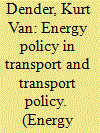

|
|
|
|
|
| Publication |
2009.
|
| Summary/Abstract |
Explanations for, and indirect evidence of, imperfections in the market for private passenger vehicle fuel economy suggest there is a reasonable case for combining fuel economy standards and fuel or carbon taxes to contribute to an energy policy that aims to reduce greenhouse gas emissions and improve energy security. Estimates of key elasticities, including the rebound effect, indicate that the positive and negative side-effects of fuel economy measures on transport activities and external costs are limited. However, an energy policy for transport does not replace a transport policy that aims to manage the main transport externalities including congestion and local pollution. Conventional marginal cost estimates and standard cost-benefit reasoning suggest that policies that address congestion and local pollution likely bring benefits at least as large as those from fuel economy measures. But the large uncertainty on the possible effects of greenhouse gas emissions constitutes a strong challenge for standard cost-benefit reasoning. Emerging results from methods to cope with this uncertainty suggest that policies to stimulate the widespread adoption of low-carbon technologies in transport are justified.
|
|
|
|
|
|
|
|
|
|
|
|
|
|
|
|
| 6 |
ID:
091527


|
|
|
|
|
| Publication |
2009.
|
| Summary/Abstract |
In response to threats posed to the future supply of energy and to the environment, the G8 leaders, in Gleneagles, UK in 2005, agreed to an initiative called the Gleneagles Plan of Action (GPOA) which addresses climate change, clean energy and sustainable development. In the GPOA, G8 leaders pledged to encourage the development of cleaner, more efficient and lower-emitting vehicles, and to promote their deployment by, among other means, asking the IEA to review existing standards and codes for vehicle efficiency and to identify best practices.
In order to properly response to the above-mentioned requests from G8 leaders, the IEA has launched, among other activities, study on policies for "transforming the way we use energy" focusing on end-use efficiency including the one in transport sector and made a comprehensive response to the GPOA at the 2008 G8 Summit Meeting in Japan with 25 recommendations on energy efficiency. Regarding these recommendations, the G8 leaders have proclaimed, in the G8 Hokkaido Toyako Summit Leaders Declaration, that they would maximize implementation of the IEA's 25 recommendations.
|
|
|
|
|
|
|
|
|
|
|
|
|
|
|
|
| 7 |
ID:
127230


|
|
Impact on electricity demand and emissions due to the introduct
/ Dias, Marcos Vinícius Xavier; Haddad, Jamil; Nogueira, Luiz Horta; Bortoni, Edson da Costa, Cruz, Ricardo Alexandre Passos da, Yamachita, Roberto Akira, Goncalves, Jose Luiz
|

|
|
|
|
| Publication |
2014.
|
| Summary/Abstract |
Over the past years, the pursuit of using less polluting energy sources throughout society has been on the increase. In general, the transportation sector is responsible for most of the emissions of greenhouse gases. Therefore, in this article a methodological approach is applied in such a way that it is possible to quantify the impact of the penetration of electric vehicles vis-à-vis others that use different types of fuel (flexible fuel, for example). The study is conducted for a road modal in São Paulo, the main state in Brazil in terms of economy, energy and environment, taking into account only automobiles. A comparative analysis of forecasting scenarios until 2035 for various inputs of electric cars in the whole state fleet is presented, aiming to verify the susceptibility of the model suggested, upon the introduction of electric vehicles, taking into account also the electrical and environmental impacts related to it. The analysis was possible due to the use of a simulation tool, Long range Energy Alternatives Planning System (LEAP), which is an energy environmental model based on scenarios, allowing an integrated and reliable support to develop studies on integrated energy planning.
|
|
|
|
|
|
|
|
|
|
|
|
|
|
|
|
| 8 |
ID:
132762
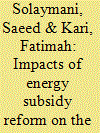

|
|
|
|
|
| Publication |
2014.
|
| Summary/Abstract |
Malaysia is paying a high level of subsidies on the consumption of energy (about 5% of its GDP). Therefore, reforming the energy subsidies, as planned by the government, will have a significant impact on household welfare and energy-intensive sectors, such as the transport sector. This study employs a computable general equilibrium (CGE) model to highlight the transmission channels through which the removal of energy subsidies affects the domestic economy. The findings show that the shock increases real GDP and real investment, while decreasing Malaysian total exports and imports. The removal of energy subsidies also decreases the aggregate energy demand, and, consequently, decreases the level of carbon emissions in the Malaysian economy. In addition, households experience significant falls in their consumption and welfare. The transport sector is significantly influenced through an increase in production costs due to an increase in the prices of intermediate inputs. The total output and total exports of the whole transport sector decrease while its imports increase. In addition, the use of all kinds of transport by households decreases significantly. The Malaysian energy subsidy reform, leads to an initial decrease in CO2 emissions and demand for electricity, gas, and petroleum products in the entire transport sector.
|
|
|
|
|
|
|
|
|
|
|
|
|
|
|
|
| 9 |
ID:
127247


|
|
|
|
|
| Publication |
2014.
|
| Summary/Abstract |
The modified Renewable Fuel Standard (RFS2) prescribes a volume of biofuels to be used in the United States transportation sector each year through 2022. As the dominant component of the transportation sector, we consider the feasibility of the light-duty vehicle (LDV) parc to provide enough demand for biofuels to satisfy RFS2. Sensitivity studies show that the fuel price differential between gasoline and ethanol blendstocks, such as E85, is the principal factor in LDV biofuel consumption. The numbers of flex fuel vehicles and biofuel refueling stations will grow given a favorable price differential. However, unless the feedstock price differential becomes extreme (biomass prices below $100 per dry ton and oil prices above $215 per barrel), which deviates from historical price trends, LDV parc biofuel consumption will fall short of the RFS2 mandate without an enforcement mechanism. Additionally, such commodity prices might increase biofuel consumption in the short-term, but discourage use of biofuels in the long-term as other technologies that do not rely on any gasoline blendstock may be preferable. Finally, the RFS2 program goals of reducing fossil fuel consumption and transportation greenhouse gas emissions could be achieved through other pathways, such as notable improvements in conventional vehicle efficiency.
|
|
|
|
|
|
|
|
|
|
|
|
|
|
|
|
| 10 |
ID:
091525


|
|
|
|
|
| Publication |
2009.
|
| Summary/Abstract |
By the end of 2006, there were about 24 million total passenger cars on the roads in China, nearly three times as many as in 2001. To slow the increase in energy consumption by these cars, China began implementing passenger car fuel economy standards in two phases beginning in 2005. Phase 1 fuel consumption limits resulted in a sales-weighted new passenger car average fuel consumption decrease of about 11%, from just over 9 l/100 km to approximately 8 l/100 km, from 2002 to 2006. However, we project that upon completion of Phase 2 limits in 2009, the average fuel consumption of new passenger cars in China may drop only by an additional 1%, to approximately 7.9 l/100 km. This is due to the fact that a majority of cars sold in 2006 already meets the stricter second phase fuel consumption limits. Simultaneously, other trends in the Chinese vehicle market, including increases in average curb weight and increases in standards-exempt imported vehicles, threaten to offset the efficiency gains achieved from 2002 to 2006. It is clear that additional efforts and policies beyond Phase 2 fuel consumption limits are required to slow and, ultimately, reverse the trend of rapidly rising energy consumption and greenhouse gases from China's transportation sector.
|
|
|
|
|
|
|
|
|
|
|
|
|
|
|
|
|
|
|
|
|